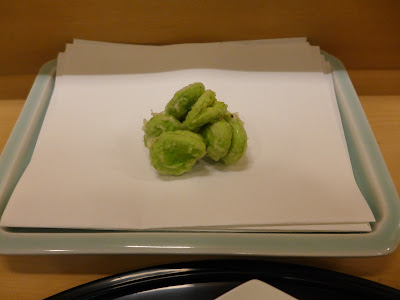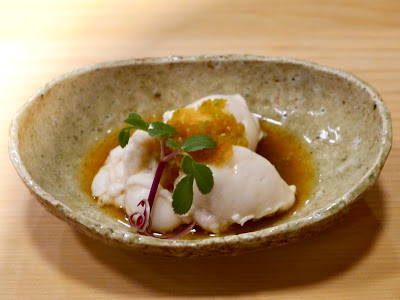Cherry blossom time is an extraordinarily beautiful time in Japan where Japanese people from all over Japan travel to follow the best of the season all up and down the country.
Seiju
Seiju is a highly rated tempura restaurant in both the Michelin Guide (1*) and Tabelog (4.!!).
Clam in clam broth topped with a shiso leaf.
Presentation for the following tempura.
Prawn.
Big fin reef squid.
Broad beans.
Bamboo shoots.
Ice fish from Shinji Lake.
Aralia sprout.
Baby ayu from Hamana Lake.
Marbled sole sashimi.
Asparagus.
Shiso roll with prawn.
Mozuku seaweed and blue crab marinated with vinegar.
Smelt whitings.
Sea eel.
Strawberry sherbet.
Aragawa
At Aragawa, sirloin beef is cut 2 or 3 cm thick and tenderloin either 5 or 6 cm thick. The beef is only seasoned with salt and pepper and cooked on metal skewers in a special oven fired with binchotan hardwood charcoal from Wakayama prefecture.
As one can see, these extraordinary steaks are all about the great attention to details of origin of every element, cooking style, etc.
Because of the very special meal we were having, we began with:
And, the wine we enjoyed was:
Crab salad.
Wild shrimp, Hokkaido.
The remarkable house smoked salmon. I order this every time i come here. Beautifully subtle smokey flavours and fabulous texture.
The presentation of the raw steak.
The steak, beautifully seared to medium rare (a must with beef with such a high degree of intramuscular marbling).
"White" strawberries.
Kohaku
Kohaku, a kaiseki restaurant, is very highly rated on tabelog and has 3 Michelin stars.The luxury of service: the small cut glass for saki retails for $600.00 (I went to the "factory", actually located in a house in the suburbs to buy some of their glass and was remarkably surprised at the cost). The silver laminated ewer was to hold our saki.
Steamed kichiji rock fish and wasabi flower dressed with egg yolk vinegar.
Deep fried baby ayu, previously lightly smoked in bamboo leaf, with sweet fish and bamboo shoot with homemade blended salt.
Grilled firefly squid with sticky rice topped with fresh salted sea urchin.
More sea urchin at our request, this urchin served was quite exceptional.
On left, Japanese prawn dumpling in clear soup (on the right, the inside of the soup cover is revealed).
Kinme snapper covered with chef's secret jelly, all topped with daikon and shiso flowers.
Scallops with it's ovary.
Charcoal grilled black throat sea perch marinated in saikyo miso, all topped with the flowers of sansho peppers. On right, Mashed fried udo plant (a mountain veg) and lotus roots.
Shiitake mushroom, quail's egg and canola flowers (slightly bitter like rapini).
Simmered hairy crab with baby turnip, sugar snap peas, giant butterroot and shiso leaf.
Jellied soft-shelled turtle.
Chopped wagyu beef and chopped broad beens for the rice below.
Steamed rice with beef and broad beans.
Pickled veg (yam and cabbage) and miso soup (no photo).
Hassaku orange ice cream, crushed walnut and walnut agar, garnished with monaka.
Sawada
Chef Sawada is especially known for his dishes of fish seared on hot coals. His wife expertly turns the fish over the sizzling coals with skewers.
Cameras are strictly forbidden so i will cite what we ate.
Flounder
Squid
Halfbeak
Ark shell
Spanish mackerel marinated in salt for 2 days and in vinegar for 3 day and then smoked with straw.
Clam
Ligament of clam
Tuna marinated in soy sauce
Chutoro (middle fatty tuna)
Shimofuri, tuna between middle fatty (chutoro) and fatty (toro).
Toro (fatty tuna) from a 275 kilo tuna from NachiKatsuura.
Gizzard shad
Sea urchin called kita murasaki uni. This uni has a slightly brinier flavour profile on my palate.
Prawn
Flounder back.
Trevally, a fish of the jack family.
Bonito (and it is here at Sawada i have tasted the best bonito anywhere).
Stuffed squid
Sunazuri tuna (tuna only grilled on its surface).
Bettara-zuke, daikon pickled in malted rice.
Geoduck clam
Sea urchin called "horse shit" sea urchin, which is named for its shape.
Sea eel
Tamago (egg cake)
Gooseberry.
A Fruit Shop
There a number of shops in Japan that specialize in fruits to be given as gifts or, in some cases, eaten on the premises.
To give you a sense of what the "gift fruits" cost in these special stores, i have photos with prices below. They are REAL and the fruits have the shape and appearance that is fruit perfection.
This group of 12 strawberries cost $102.00, that is $8.50 EACH!!This bunch of grapes cost $164.00.
This watermelon is $127.00.
This cantaloupe is $317.00!! So, you get the idea!
While at the fruit shop we chose an orange and a grapefruit to taste for which the cost was $217.00. The grapefruit was unpleasantly very pulpy/seedy. The orange had a beautiful appearance and was quite tasty. However, would I order this kind of fruit to eat, NO! Not to taste, but, perhaps to give as a gift in Japan, I understand.
Tomura
Tomura is very highly rated on Tabelog and presents Kyoto style cuisine (Kyo-ryori cuisine). This is a very difficult reservation to get as besides being in high demand the resto only has 6 counter seats or a private room such as we had.
Our personal server in our private tatami matte room.
The first presentation, chawanmushi.
The chawanmushi (egg custard) with clam.
Bamboo shoot topped with sansho leaves (the leaves have a peppery taste).
Sesame custard topped with sea urchin.
On the far right, bottom, firefly squids; left bottom, eggplant topped with sea urchin; top left, white asparagus mixed with soy bean curd; top right, ebi yam.
Sashimi of ark shell clam (akagai) and red snapper.
Greenling and plum in soup, topped with sansho leaves.
Ohmi beef, one of the top 3 types of wagyu beef in Japan (the others are Kobe and matsusaka ushi), accompanied by Akaza prawn.
Kuze egg plant simmered in its own broth. The technique in making this sublime version is to deep fry the eggplant, remove from the oil and then simmer it in eggplant broth with sugar and soy sauce, then keep it in the broth for a while before serving.
Presentation of the noodle soup accompanied by pickled veg.
Wheat noodle (nyumen) with clear hot broth.
Lotus mochi and black sugar syrup, accompanied by soy bean powder (flour) (below), for dusting.
Tsujitome
Tsujitome is highly rated on Tablelog and has 2 Michelin stars.
Originally founded in Kyoto, Kaiseki Tsujitome is a kaiseki-style restaurant. With the guidance of the grand tea master of Urasenke, the prestigious school of tea has continued since 1658. Kaiseki Tsujitome was given privilege to cater to the school in Kyoto. The culinary technique and artwork of the chef has evolved and been inherited for three generations since 1902. The former chef Tsuji is the 3rd generation and his teacher was Rosanjin kitaoji, a well known chef, antique collector, calligrapher and potter. The scroll, see in the tokonoma, at the back of the room below,is a design of napkin and the calligraphy on the chop stick cover made by Rosanjin.
The colorful presentation of each dish is designed to represent the beauty of the season. The experience of indulging in this cuisine in a private room setting is an artful entertainment.
Our alcove of honour (tokonoma) in the background, and our private tatami matte room.
This was a truly unique experience: sashimi of 5 different kinds of sea urchin. In the centre, greenling sashimi (udo) (aralia cordata); bottom right, dried sea cucumber ovaries.
Presentation.
Lobster dumpling in soup, topped with shiso and pine needles.
Presentation.
Soy bean curd topped with sansho leaves paste on skewers (tofu dengaku).
On left, prawn steamed with sake; top, raw wheat gluten mochi with yuzu paste wrapped in cherry leaf; baby ayu simmered in sweet broth; roasted duck marinated in soy bean paste.
Bamboo shoot, snapper roe and giant butterbur.
Trout grilled in yuan style (soy sauce, sake, mirin and yuzu).
Simmered abalone topped with sea urchin.
Tempura of bamboo shoot, prawn and green pepper.
Chicken filet with sesame paste with hamabofu (a Japanese veg).
Bamboo shoot rice serve with pickles accopanied by a bowl of miso soup with clams and wakame seaweed.
Naval orange and strawberry.
Cherry blossom shaped sweet filled with white red bean paste.
Traditonal whipped matcha tea.
Kyoaji
Kyoaji has an extremely high ranking on Tabelog and is one of the two restaurants in Tokyo which rejected their award of three stars from the Michelin Guide. This is Kaiseki cuisine at its best.
Kyoaji doesn't take reservation from 1st time customers. You need to be taken by a regular first and the resto will accept reservations from you. This is the way it is with most top Japanese restaurants, which usually seat less than 20 people. Most of these restaurants don't want anything to do with Michelin since they have enough regular customers and want to keep their restaurant a special place for their clients to dine. There are stories of wealthy people from around the world waving cash to eat here, but were still rejected.
The present master chef/owner Kenichiro Nishi's father, was considered the best chef in kyoto when he was alive.
From the left, baby ayu; prawn sushi; snapper; butterbar.Presentation.
Usui beans simmered in veg broth.
Snapper milt (sperm).
Sea urchin with snapper bone broth jelly and lily bulb.
Presentation.
Soy bean curd topped with sansho leaf paste with skewers (tofu dengaku).
Tempura of clam ligament and auralia sprouts.
Presentation.
Greenling and bracken in soup.
Vinegared crab, ocellated octopus all topped with crab meat (no photo).
Rice with beans.
Mozoku seaweed.
Rice with salmon.
Mochi surrounded by warabi flour.
Sweet adzuki bean soup (no photo).




































































































No comments:
Post a Comment